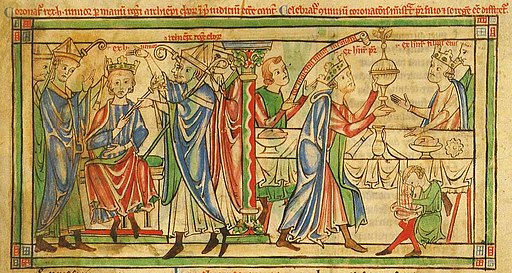Dr Emily Ward’s blog post responds to an new BBIH online reading list of 375 publications focusing on the history of monarchy and coronations in Britain and Ireland up to 1485. The list specifically covers:
- Succession, royal, a subcategory of Monarchy (within Political, administrative and legal history)
- Coronations, a subcategory of Ceremonies (within Other topics).
The 12th-century chronicler Gerald of Wales was concerned that many monarchs of his day did not take their royal responsibilities seriously enough. ‘Which ruler today pays attention to what the sacrament of anointing of kings, what the crown and sceptre and all the insignia mean?’, he lamented in the preface to his Instructions for a Ruler.

Coronation of Henry the Young King – Becket Leaves (c.1220-1240). Matthew Paris, Public domain, via Wikimedia Commons
Medieval kings may not have been thinking enough about such issues, but historians in the modern world evidently have, as the Bibliography of British and Irish History (BBIH) newly curated reading list on monarchy and coronations up to 1485 demonstrates. From studies of dynastic succession in early medieval Wales to articles on Irish inauguration rituals or discussions of claimants to the Scottish throne, the online list is an exciting tool for those interested in royal rulership across medieval Britain and Ireland. My own research, which has explored the lives of royal children and boy kings between the 11th and 13th centuries, has benefited from consulting the rich scholarship on child rulers and regencies in later medieval Scotland and England. This reading list—which places contributions on Beowulf in 7th-century East Anglia alongside those on 15th-century political iconography—will similarly encourage students and scholars to extend the breadth of their investigations by looking across traditional chronological boundaries.
Different regions could have distinctive practices of succession. Long-standing debates regarding Duke William of Normandy’s claim to the English throne in 1066, for example, have often hinged on contrasting legal customs in 11th-century Normandy and England. Rituals of royal inauguration could likewise vary from kingdom to kingdom. Crowns and sceptres may have been the most significant insignia according to Gerald of Wales, but these were hardly universal signs of monarchic authority. In 1249, the eight-year-old Alexander III likely became the first king of Scots to wear a crown during his inauguration ceremony, but it wasn’t until a century later that Scottish rulers gained papal approval to receive ‘the sacrament of royal anointing’.

Coronation of King Alexander on Moot Hill, Scone. Wikipedia
A comparative methodology helps historians to situate such distinctions within a much wider context, and to appreciate similarities across time and space. To provide an example from my recent research: comparing cases of child kingship between multiple realms—Scotland, England, France, and Germany—further accentuates the importance of children as embodiments of royal and dynastic power by the mid-13th century. The BBIH’s new reading list will hopefully inspire students embarking on similar comparative projects on medieval monarchy in future. An excellent place to start would be Johanna Dale’s multi-layered work on liturgical kingship, Alheydis Plassmann’s insightful comparison of English and German succession strategies, or David Warner’s parallel assessment of Anglo-Saxon and Ottonian coronations.

Medieval monarchy was by no means an exclusively man’s world, even if monastic writers sometimes struggled with the concept of ‘a female king’ when queens ruled in their own right. Other royal women supported young sons and daughters on the throne, or played essential roles at times of succession, facilitating moments of political change or crisis. The thriving field of research into queenship is well-represented throughout this new reading list, which features studies on queen-making, queenly treasure, matriarchal power, female succession, and more. Engaging with the wealth of research showcased here, whether specifically on queenship or on medieval monarchy more broadly, is a valuable way to learn about unfamiliar case studies, to observe shifting historiographical trends, and to encounter new ideas and methodologies.

Dr Emily Joan Ward is a British Academy Postdoctoral Fellow at The University of Edinburgh, where she will take up a Lectureship in Medieval Scottish History from January 2024. Her first book, Royal Childhood and Child Kingship: Boy Kings in England, Scotland, France and Germany, c.1050–1262, was published with Cambridge University Press in 2022.
- Twitter: https://twitter.com/1066Unicorn
- Institutional page: https://www.ed.ac.uk/history-classics-archaeology/about-us/staff-profiles/emily-ward
- ORCID: https://orcid.org/0000-0002-3883-0152

